Try our delicious bread pudding dessert recipe for a taste of classic comfort. It’s simple to make and perfect for any time. It’s great for both beginners and seasoned bakers.
Our simple dessert recipe adds a creamy custard twist to the traditional bread and butter pudding. It’s warm, sweet, and velvety. This dessert will quickly become a favorite in your family.
Key Takeaways
- Easy-to-follow instructions for a classic dessert
- A delicious twist on traditional bread pudding
- Creamy custard adds a rich and velvety texture
- Perfect for novice and experienced bakers alike
- A comforting and satisfying treat for any occasion
The Charm of Bread and Butter Pudding
Bread and butter pudding is a timeless dessert that warms the heart and delights the taste buds. It’s a classic bread pudding recipe that has been passed down through generations, with each family adding their own twist.
A Beloved Classic Dessert
The homemade bread and butter pudding is more than just a dessert; it’s a comfort food that brings people together. Made with simple ingredients like bread, butter, and eggs, it’s a treat that’s both rich and humble. The traditional bread pudding recipe has been a staple in many cuisines, including British cuisine, where it’s often served warm with a custard sauce.
| Key Ingredients | Role in the Recipe |
|---|---|
| Bread | Provides texture and base flavor |
| Butter | Adds richness and flavor |
| Eggs | Binds the ingredients together |
Why This Recipe Stands Out
What makes this traditional bread pudding recipe stand out is its simplicity and versatility. The recipe allows for various customizations, such as adding dried fruits or nuts, making it a favorite among those who enjoy experimenting with different flavors. The end result is a deliciously homemade bread and butter pudding that’s sure to impress.
History and Origins of Bread and Butter Pudding
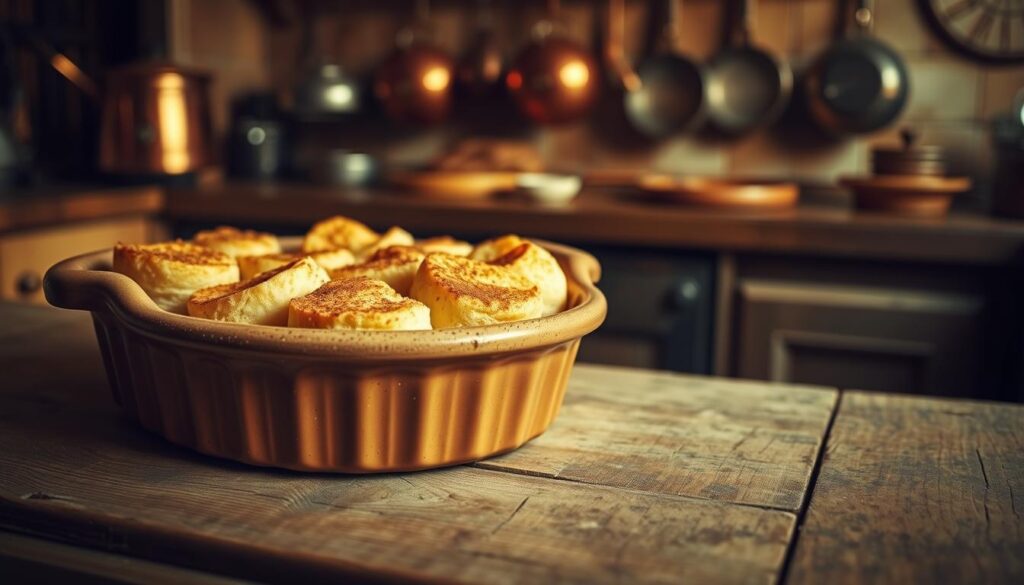
The story of bread and butter pudding is one of transformation. It went from a simple, frugal dish to a gourmet delight. This classic dessert comes from traditional British cuisine, where it was made to use up stale bread.
British Roots and Evolution
Bread and butter pudding started in Britain in the early 17th century. Back then, being thrifty in cooking was key. Cooks would soak stale bread in a mix of milk, eggs, and sugar, then bake it. This made a warm, comforting dessert.
Over time, this simple dish got richer. It started to include dried fruits and spices. This change came from global trade’s influence on British cuisine.
Related: Spotted Dick Recipe: Discover the Iconic British Pudding
From Frugal Dish to Gourmet Delight
As cooking techniques and tastes changed, bread and butter pudding became more sophisticated. It got richer with ingredients like cream, chocolate, and quality spices. Now, it’s a favorite in fancy restaurants and homes.
| Period | Description | Key Ingredients |
|---|---|---|
| 17th Century | Originated as a frugal dish | Bread, milk, eggs, sugar |
| 18th-19th Century | Incorporation of richer ingredients | Dried fruits, spices, sometimes alcohol |
| 20th Century onwards | Elevation to gourmet status | Cream, chocolate, high-quality spices |
The evolution of bread and butter pudding shows how cooking changes over time. It went from a simple dessert to a gourmet treat. This shows how culinary traditions can evolve and grow.
Essential Ingredients for the Perfect Bread and Butter Pudding
The secret to a perfect bread and butter pudding lies in its ingredients. Choosing the right ones is key for the perfect texture and taste.
Bread Selection: What Works Best
Choosing the right bread is essential. Brioche or Challah are top picks because of their rich, egg-based dough. For the best results, use bread that’s a day or two old. It soaks up the custard better.
Using a mix of white and whole wheat bread adds depth to the flavor.
Dairy Components
Dairy is vital for the custard that holds the pudding together. Whole milk and heavy cream make it creamy. Eggs add structure and richness. Adding vanilla extract or a pinch of salt can enhance the flavor.
Sweeteners and Flavorings
Sweeteners and flavorings can take your pudding to the next level. Granulated sugar is common, but dark brown sugar adds a deeper taste. Try adding cinnamon, nutmeg, or dried fruits for extra sweetness and complexity.
Equipment You’ll Need
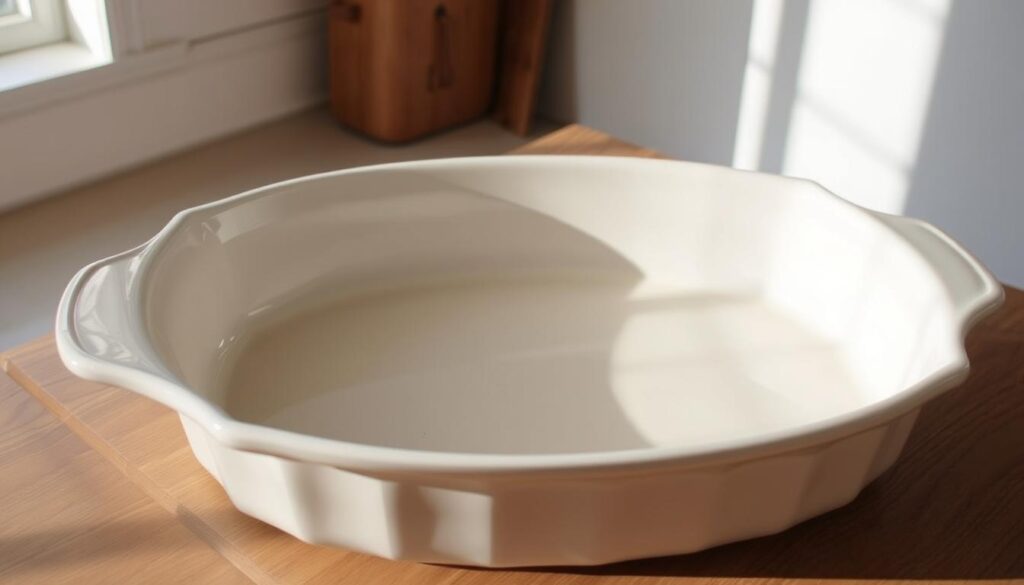
To start making bread and butter pudding, you need some key kitchen tools. The right equipment makes preparing the dessert easier. It also helps your dessert come out perfectly.
Baking Dish Considerations
Choosing the right baking dish is key for your bread and butter pudding. A ceramic or glass dish is best because it heats evenly. Make sure the dish is big enough to hold all the ingredients without spilling over. A 9×13 inch dish is usually the right size for most recipes.
Other Essential Tools
You’ll also need a few more tools to make your bread and butter pudding. You’ll need a mixing bowl to mix ingredients, a whisk to beat eggs and sugar, and a breading knife to cut bread. Having these essential tools ready will help you work more efficiently.
Preparing the Bread
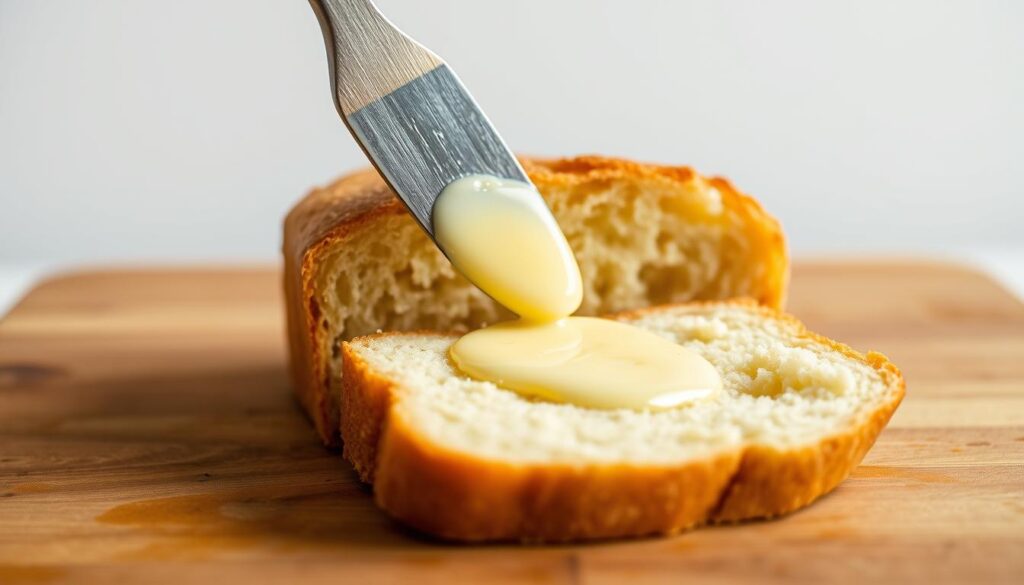
The art of preparing bread for bread and butter pudding is special. It requires careful slicing and buttering to get the right texture and taste.
Slicing and Buttering Techniques
First, slice your bread into thick, even pieces. A serrated knife makes clean cuts easier. Then, butter each slice generously on both sides. This step boosts the flavor and texture of your pudding.
Creating the Perfect Layers
After buttering, start layering. Place a bread layer at the bottom of your dish. Add dried fruits or nuts before the next bread layer. Keep layering until you use all your ingredients, ending with a bread layer on top. This layering is essential for a great bread and butter pudding.
The Complete Bread and Butter Pudding with Custard Recipe
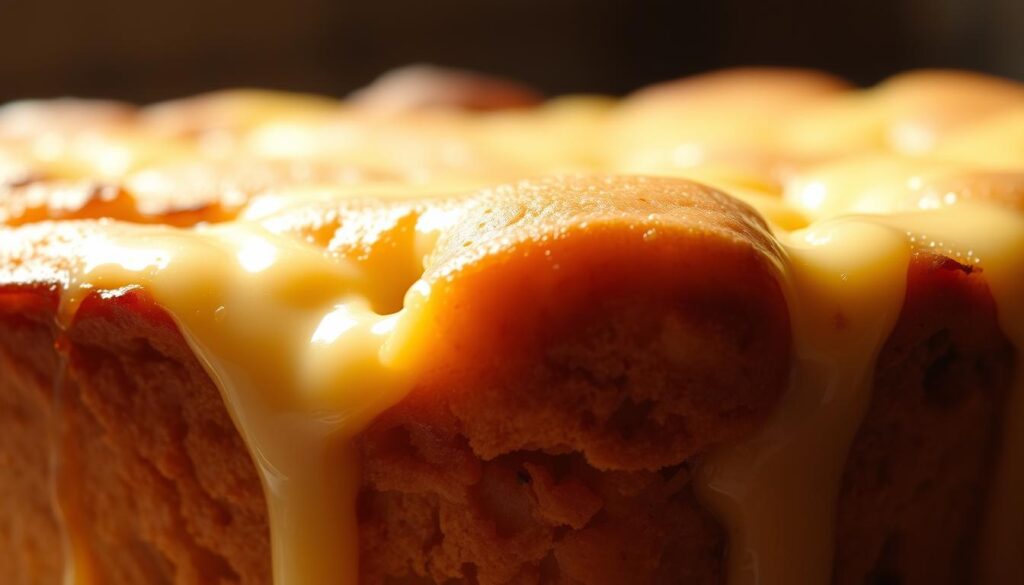
Here’s the full recipe for bread and butter pudding with custard. This classic dessert is loved for good reason. With our help, you’ll make a rich, creamy, and delicious pudding that will wow your loved ones.
Ingredient Measurements
To make this pudding, you’ll need: 4 cups of stale bread, cut into 1-inch cubes; 1/2 cup of unsalted butter, softened; 1 cup of granulated sugar; 2 large eggs; 2 cups of heavy cream; 1 tsp of vanilla extract; and a pinch of salt. For the custard base, you’ll need 2 cups of milk, 1/2 cup of heavy cream, 1/2 cup of granulated sugar, and 3 large egg yolks.
Step-by-Step Instructions
Follow these steps to create your bread and butter pudding with custard:
Preparing the Bread
Start by buttering the bread cubes on all sides. Then, layer them in a 9×13-inch baking dish. Make sure to leave some space between the cubes for even cooking.
Making the Custard Base
In a medium saucepan, mix the milk, heavy cream, and granulated sugar. Heat over medium heat, stirring occasionally, until the sugar dissolves and the mixture is hot but not boiling. In a separate bowl, whisk the egg yolks. Gradually pour the warm milk mixture into the egg yolks, whisking constantly.
Assembly Process
Pour the custard base over the bread cubes, making sure all the bread is coated. Let it sit for 10-15 minutes to allow the bread to absorb the custard.
Baking Guidelines
Bake the pudding in a preheated oven at 350°F for 35-40 minutes, or until it’s golden brown and set. Remove from the oven and let it cool for a few minutes before serving.
Recipe Timing and Yield
This bread and butter pudding with custard recipe serves 8-10 people. It can be prepared in about 1 hour and 15 minutes, including baking time. You can make it ahead and refrigerate or freeze it for later, making it perfect for special occasions or holidays.
Making the Perfect Custard Sauce
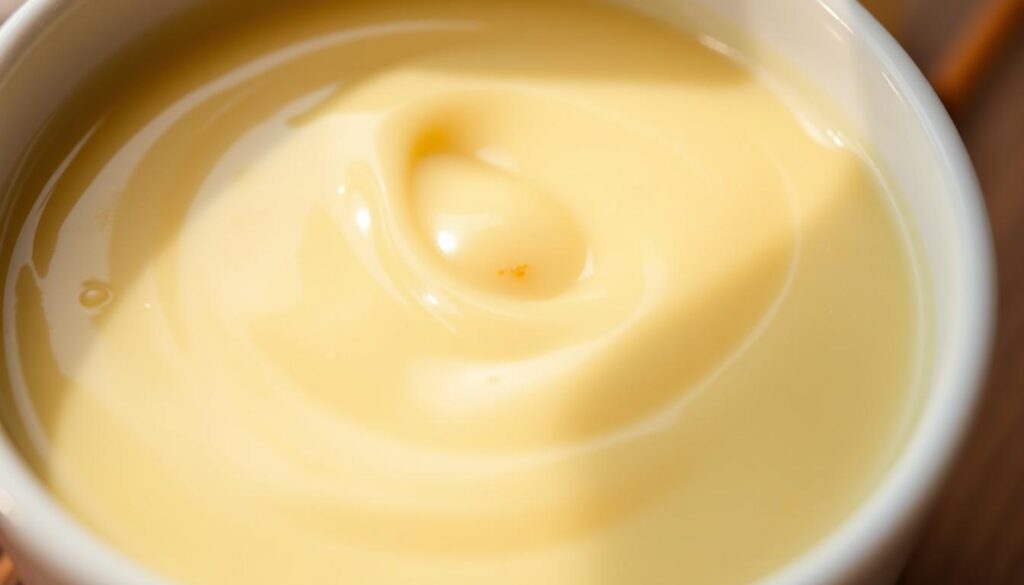
Making the perfect custard sauce is all about balance. It’s about using the right ingredients and techniques. A good custard sauce can turn simple bread and butter pudding into a fancy dessert.
Custard Ingredients
The base of a great custard sauce is simple. You need eggs, milk, sugar, and vanilla. For the best taste, use fresh eggs and full-fat milk.
- 2 large egg yolks
- 1 cup whole milk
- 1/2 cup granulated sugar
- 1/2 teaspoon vanilla extract
Cooking Method
The way you cook the custard is key to its smoothness. First, heat the milk and sugar until it starts to simmer. Then, whisk together the egg yolks and vanilla in a separate bowl.
Pour the warm milk mixture into the egg yolks slowly, whisking all the time. This prevents the eggs from scrambling. Put the mixture back in the saucepan and cook on low heat, stirring constantly, until it thickens.
Troubleshooting Common Custard Issues
Even with careful preparation, custard sauce can sometimes go wrong. If it’s too runny, it might not have cooked enough. If it’s too thick, it’s cooked too long.
Straining the custard through a fine-mesh sieve can help. It removes any lumps or egg solids that form during cooking.
“The key to a silky custard is tempering the eggs gently and cooking the mixture over low heat.”
Common Mistakes to Avoid

To make sure your bread and butter pudding is perfect, avoid common mistakes. A few errors can ruin the dish. But knowing what to watch out for helps you avoid these problems.
Bread Selection Errors
Picking the right bread is key. Avoid fresh or too dense bread as it messes with the pudding’s texture. Go for bread that’s a day or two old, with the right softness and density.
Custard Consistency Problems
The custard is a must-have in bread and butter pudding. Don’t overcook or undercook the custard as it can ruin the texture. Cook it until it’s just thick, and don’t let it boil.
Baking Missteps
Baking the pudding needs careful attention to temperature and time. Baking too hot can burn the top before the inside is cooked. Use a water bath to control the temperature.
| Common Mistake | Effect on Pudding | How to Avoid |
|---|---|---|
| Using fresh bread | Poor texture | Use day-old bread |
| Overcooking custard | Rubbery texture | Cook until just thickened |
| Baking at too high temperature | Burnt top, undercooked inside | Use a water bath |
By knowing these common mistakes and how to avoid them, you can make a delicious bread and butter pudding. It’s sure to impress everyone.
Delicious Variations to Try
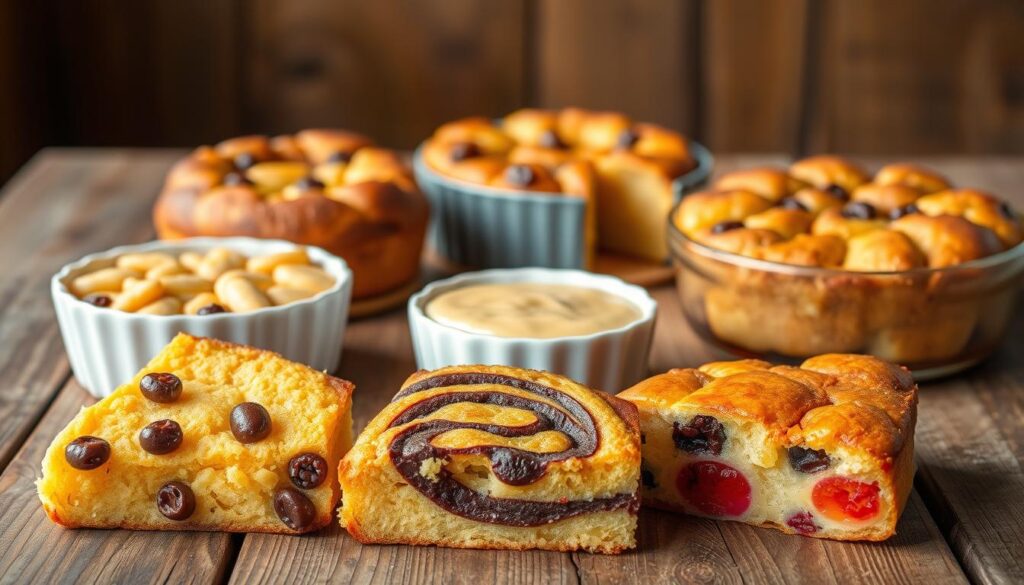
The classic bread and butter pudding recipe is a great base for your creativity. You can add different ingredients to make unique versions that everyone will love.
Fruit Additions
Adding fruits to your bread and butter pudding brings natural sweetness and flavor. Try using dried cranberries, cherries, or fresh berries like strawberries or blueberries. Just layer them with the bread in the baking dish.
- Dried cranberries for a tangy twist
- Fresh berries for added moisture
- Canned fruit like peaches or pears for a different texture
Chocolate Lover’s Version
Chocolate lovers will adore adding cocoa powder or chocolate chips. It turns the bread and butter pudding into a rich dessert. Drizzle chocolate sauce on top for extra indulgence.
- Add cocoa powder to the custard mixture
- Layer chocolate chips with the bread
- Top with chocolate shavings or chocolate sauce
Adult-Only Options with Spirits
For an adult-only twist, add a splash of liquor. Rum, brandy, or Grand Marnier enhance the dessert’s flavor. Soak the bread in liquor or add it to the custard.
- Rum-soaked raisins for added flavor
- A splash of brandy in the custard
- Grand Marnier for a citrusy note
These variations let you make the bread and butter pudding your own. It’s perfect for any special occasion.
Storage and Make-Ahead Options
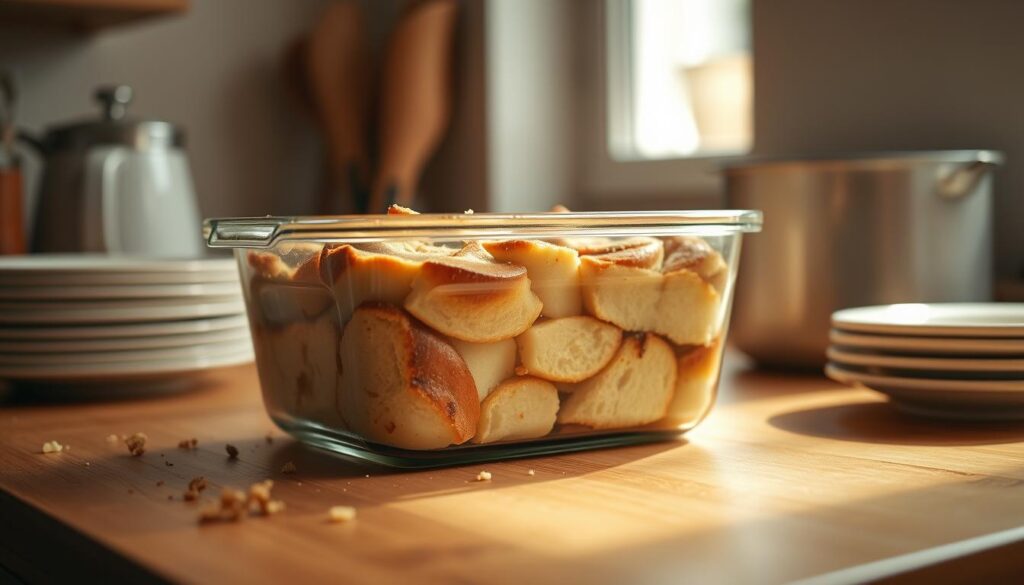
Making bread and butter pudding ahead of time can be a real game-changer. It’s perfect for events or when you’re short on time. This dessert is flexible and can be stored or made ahead in various ways.
Refrigeration Guidelines
For short-term storage, refrigeration is a good option. Prepare the bread and butter pudding as instructed, but don’t bake it. Cover it tightly with plastic wrap or aluminum foil and refrigerate for up to 24 hours before baking.
If you’ve already baked it, let it cool completely. Then, cover it and refrigerate. Reheat in the oven at 350°F (175°C) until warmed through.
Freezing and Reheating Tips
For longer storage, consider freezing. Prepare the pudding as instructed, but again, do not bake. Wrap it securely and freeze for up to 3 months.
To bake, thaw overnight in the refrigerator, then bake as directed. Or, bake the pudding first, let it cool, then freeze. Reheat frozen, baked pudding in the oven, covered, at 325°F (165°C) until heated through.
Serving Suggestions and Pairings
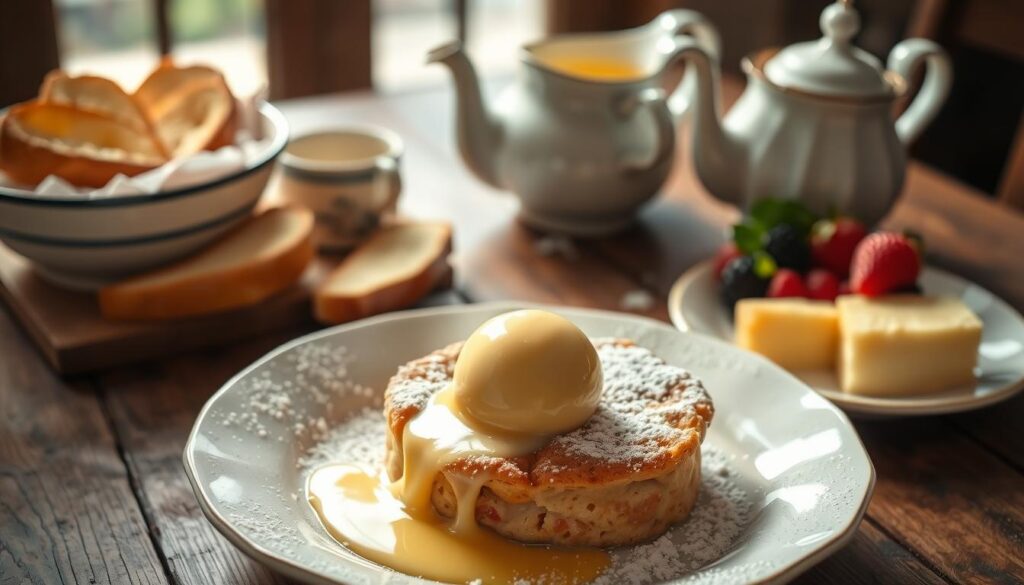
Make your bread and butter pudding special with serving suggestions and drinks. The right way to serve and what to pair it with can make this classic dessert unforgettable.
Temperature Considerations
It’s important to serve bread and butter pudding at the right temperature. It tastes best when it’s warm, straight from the oven. If it’s been in the fridge, let it come to room temperature before serving. Don’t serve it cold, as it can lose its flavor. When reheating, do it gently to keep the pudding moist.
Complementary Beverages
Choosing the right drink to go with your bread and butter pudding can really bring out its flavors. Coffee and tea are always good choices. For a richer experience, try a dessert wine or a liqueur like rum or brandy.
Additional Toppings and Garnishes
Adding extra toppings or garnishes can make your bread and butter pudding even more special. Try fresh berries, a dollop of whipped cream, or a sprinkle of powdered sugar. These can add both taste and beauty to your dessert.
Conclusion
Bread and butter pudding with custard is a timeless classic. It’s loved for its rich, comforting flavors. This custard recipe adds a creamy touch, making it even more special.
By following the steps in this article, you can make a delicious bread and butter pudding. You can also try adding fruit or chocolate to make it your own. This way, you can give the dessert a unique twist.
Serving it warm or at room temperature, bread and butter pudding is always a winner. So, why not try making it and enjoy the experience? As you take a bite, you’ll see why it’s a favorite dessert for so many.
FAQ
What is the best type of bread to use for bread and butter pudding?
The top bread for bread and butter pudding is a day-old bread. Brioche, challah, or a crusty baguette work best. They have a rich texture and flavor that enhances the pudding.
Can I make bread and butter pudding ahead of time?
Yes, you can make the bread and butter pudding mixture ahead. Refrigerate it overnight. This lets the bread soak up the custard, making it more flavorful.
How do I prevent my custard from curdling?
To avoid curdling, cook the custard slowly over low heat. Stir constantly until it thickens. Don’t boil it, as boiling can cause curdling. Also, temper the eggs by slowly adding hot milk while whisking.
Can I freeze bread and butter pudding?
Yes, you can freeze bread and butter pudding. Cool it completely, then wrap it tightly in plastic or foil. Freeze for up to 3 months. To reheat, thaw in the fridge and bake at 350°F until warm.
What are some variations I can try with the classic bread and butter pudding recipe?
Try adding dried fruits, nuts, or chocolate chips to the bread. Use different breads like croissants or cinnamon raisin for unique flavors.
How do I make a simple custard sauce from scratch?
Mix milk, sugar, and eggs in a saucepan. Cook over medium heat, stirring constantly, until it thickens. Strain it through a fine-mesh sieve into a clean bowl to remove egg solids.
Can I use store-bought custard instead of making my own?
Store-bought custard is convenient but homemade is richer. If you’re short on time, store-bought custard can make a delicious pudding.
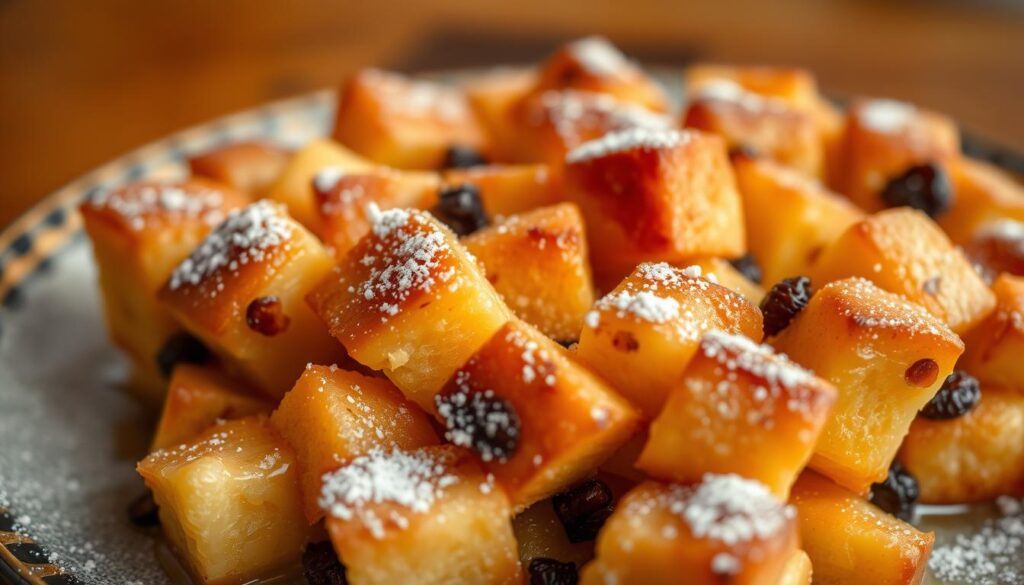


Pingback: Spotted Dick Recipe: Discover the Iconic British Pudding